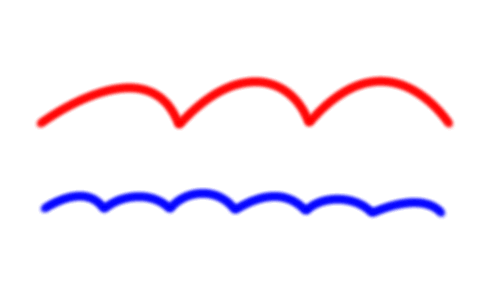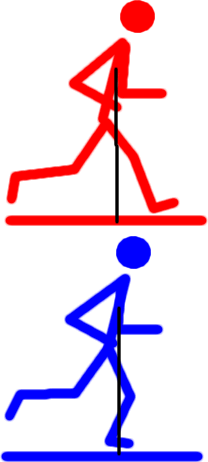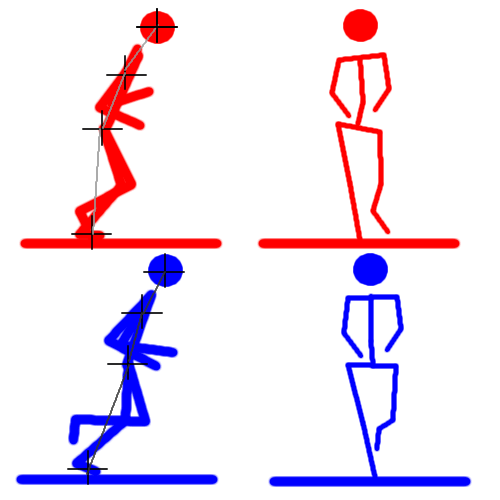Thinking about Running Technique
Here are a few words and phrases which might be used to describe a good runner: light on the feet, bouncy, ‘quick’, floating, easy, relaxed, flowing, taut…
Here are a few words and phrases which are more likely to spring to mind when watching many runners at the average running race, marathon or triathlon: tired, heavy, flat footed, plodding, uncomfortable, painful, ‘slow’, saggy…
If you ran as a kid, and have been running ever since, there is a fair chance that you will be able to run well without having to think about it too much.
If that isn’t the case don’t despair. There are a few things that you can do to improve your running technique – and simply running more miles isn’t necessarily one of them. Learning new techniques, however, does take time so, though you might feel a change straight away and for a short distance, it will probably take a while before your you see the impact on your times and results.
The first thing to do is to understand a little of the mechanics of running – just enough to understand what it is you are trying to achieve, which things will be beneficial and which things will be counter productive. And why.
The aim of running is simply to propel your body forward as quickly and efficiently as possible. Any energy that doesn’t contribute to propelling the body forward is wasted. This could be energy which is used to push in the wrong direction or energy which is not converted to movement in any direction.
I don’t care how efficient I am, I just want to go faster… It’s a pretty safe bet that if you are running more than 50 meters then you already have the ability to run faster. To run faster times, however, you must be able to keep going. Eating will provide you with the fuel, a trained cardiovascular system will carry the fuel to the muscles, strong muscles will turn the fuel into a lot of force ...and inefficient technique will waste it.
Here are a few ways in which running can easily become inefficient:
- lifting your body needlessly up and down
- moving from side to side
- using energy to resist forward motion
- absorbing energy instead of using it to move forwards
- generating noise
- transmitting energy into your running shoes
There are three aspects of running technique which can help to address all of these and the good news is that none of them requires any particular talent. They are 1) a high cadence, 2) midfoot landing and 3) core stability.
High cadence
With a few exceptions good runners have a high cadence. By high cadence I mean over 90 cycles per minute (180 foot strikes). Besides minimising the loading on joints and muscles a high cadence minimises the distance that the body moves up and down.

The longer the body is in the air the greater the effect of gravity – more energy is required to throw the body up and more is required to catch it when it comes back down.
Developing a high cadence takes time. Initially running with a very high cadence (and very short strides) uses a lot of energy and isn’t relaxing. A good strategy is to introduce short periods into your runs – say one minute in each five. After a couple of runs move onto two minutes in six and so on.
Midfoot landing - or not heel striking
As observed above, the aim of running is to propel your body forward. If your foot lands in front of your centre of gravity it will resist your forward motion. If it lands underneath or behind it will contribute. If it lands underneath or behind it cannot land heel first.

The red runner cannot use his front leg to propel himself forward. He’ll have enough momentum to keep going but before the front leg can contribute to forward movement it will first resist forward motion and must then propel the body back upwards. What a waste.
The blue runner’s front leg is landing right under his centre of gravity. His forward momentum is unimpeded and as soon as he extends his leg the force will be pusing him forwards too.
But I thought that I was supposed to land on my heels? Why do running shoes have all that cushioning in the heels?
Consider this for a moment. Track and cross country shoes (‘spikes’) have the spikes under the forefoot and no cushioning at all under the heel. Also remember that mankind has been running for a lot longer than running shoes have been around – and many of the African distance runners who dominate middle and long distance running ran barefoot as children.
Unfortunately running shoes do not encourage good running. A little like luxury cars they enable us to get away with poor technique.
By landing on the midfoot runners are able to use the bones and muscles in the foot to store energy and to use it for propelling themselves forwards. Good running is silent.
Simply changing your technique from heel strike to midfoot strike is highly likely to result in very stiff calf muscles and then injury. Again a policy of little by little is called for starting with a few minutes and increasing by a small percentage on each run. Ultimately, with so much less impact, the likelihood of injury will be much less.
Core stability
When running the propulsive force is transmitted up one leg, through the pelvis and up the spine. Significantly the leg and spine are not co-axial – they do not align. In order for force to be efficiently transmitted from one to the other the pelvis has to remain rigid and horizontal. The muscles that keep the pelvis in position, the core, are crucial for maintaining efficient running form.
Viewed from the front they have to keep the pelvis horizontal, viewed from the side they have to keep the pelvis under the centre of gravity to ensure that forces generated by the legs are transmitted through both. This is the meaning of ‘running tall’.

The red runner does not have a strong core. The blue runner has his hips forwards and holds his pelvis level. The force from his legs is transferred efficiently through his hips, pelvis, spine, neck and head.
Core stability can be developed specifically through postural exercises and activities such as Pilates and Yoga. Simply concentrating on good posture is a start, and not just when running either. Any time, whatever you are doing (standing, sitting, lying down, active or passive), is a good time to concentrate on good posture and it isn’t just your running that will benefit.
Tim Williams. November 2003.
